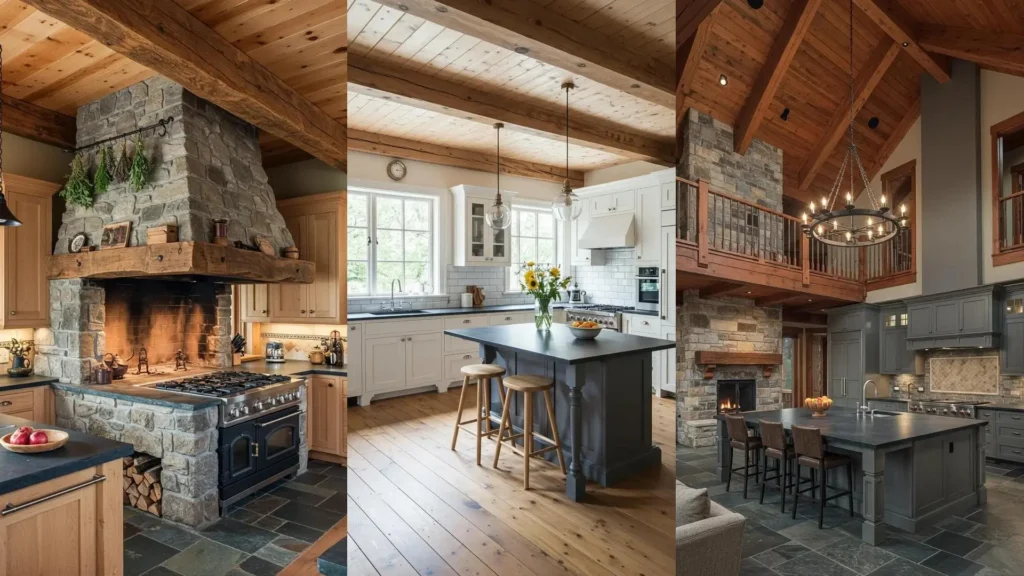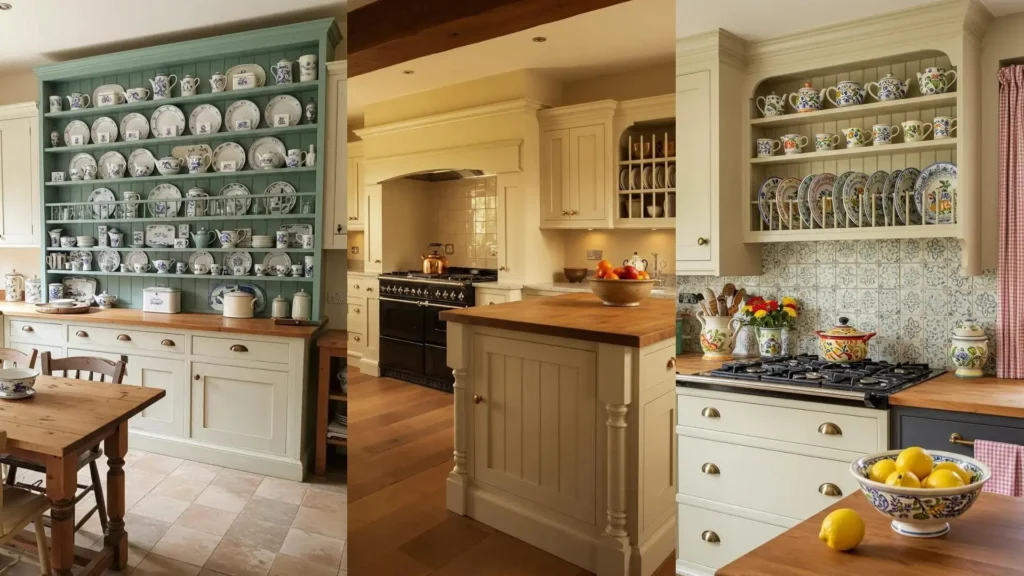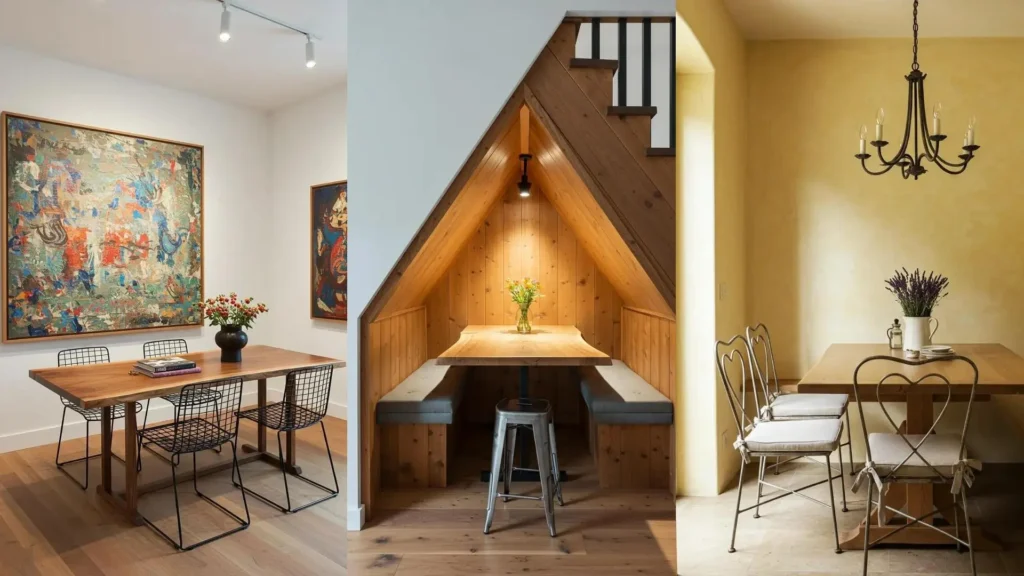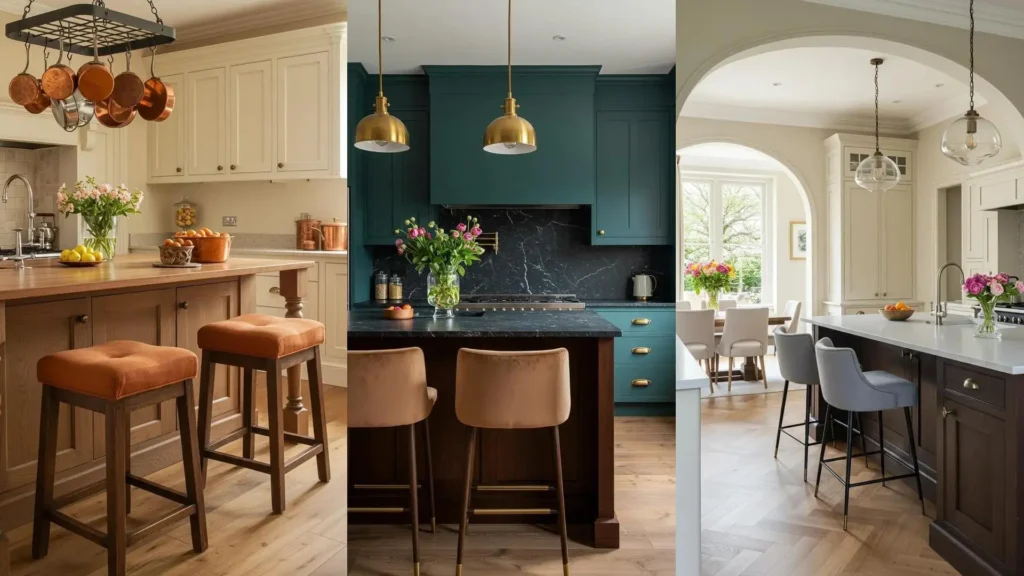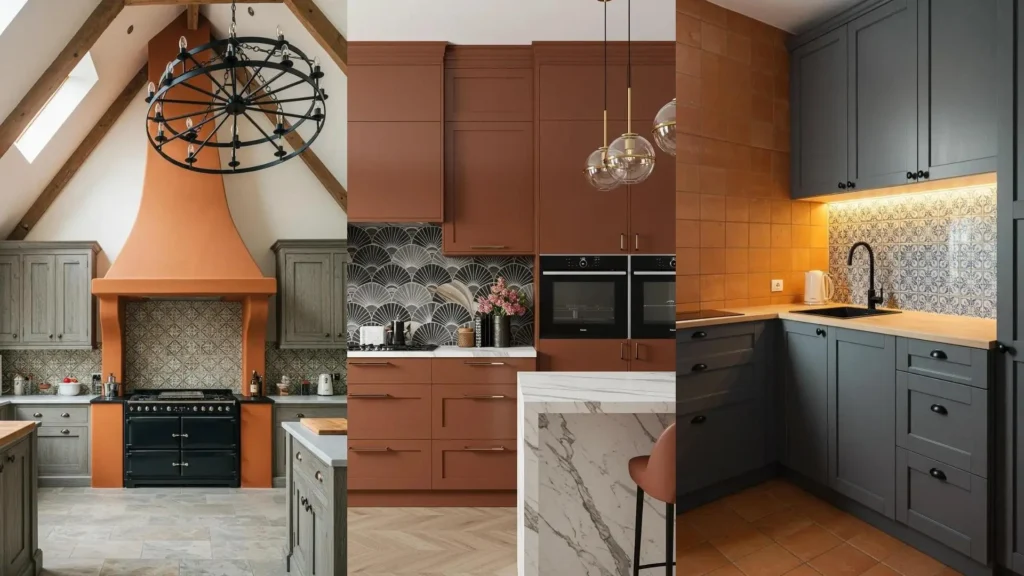Creating a dining room that feels both peaceful and personal can seem like a complex task, but it often begins with a simple, powerful pairing: the honesty of raw wood and the softness of natural linen.
This is the heart of Japandi design—a philosophy that finds elegance in simplicity and warmth in craftsmanship.
Here, you won’t find fleeting trends. Instead, you’ll discover how to use light, texture, and thoughtful composition to create a space that calms the mind and invites connection. Let’s explore how you can bring this serene and sophisticated style into your own home, one intentional choice at a time.
1. Master the Art of Diffused Light
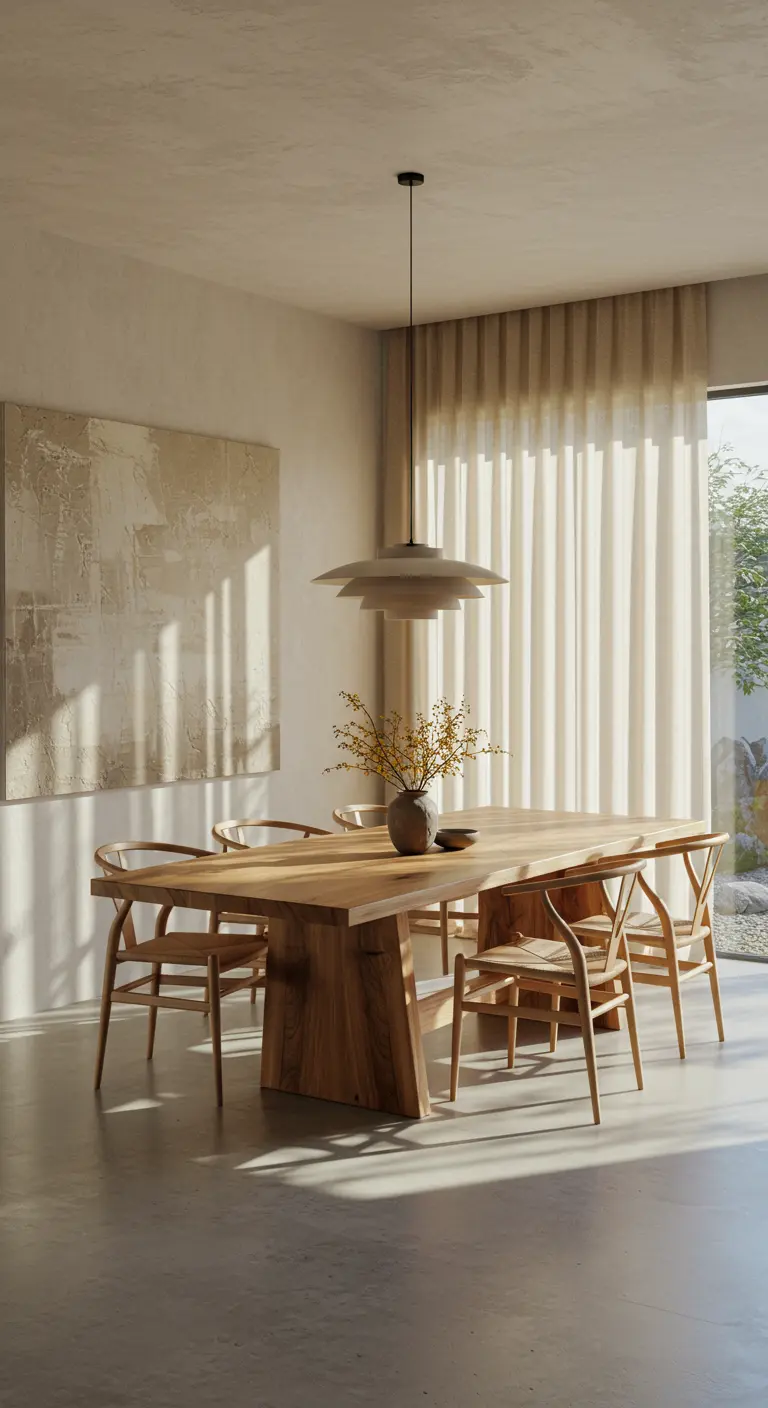
Instead of leaving a large window bare, use a single panel of wall-to-wall sheer linen curtains.
This simple addition transforms harsh sunlight into a soft, diffused glow that enhances the natural textures in the room, from the raw oak table to the concrete floors.
It also provides a layer of privacy without sacrificing brightness, creating an atmosphere of serene intimacy.
For a similar effect on the wall, consider limewash paint or a DIY textured art piece using joint compound on a canvas.
2. Ground Your Space with Deliberate Contrast

To prevent an all-wood space from feeling monotonous, introduce high-contrast elements in matte black.
Pairing a light oak table with black dining chairs and matching pendant lights creates a clean, graphic silhouette that feels both modern and timeless.
This technique draws the eye and defines the dining zone within an open-concept layout, as seen in these Japandi-style kitchens.
If black feels too bold, try a deep charcoal grey or a rich espresso brown for a softer, yet equally effective, contrast.
3. Carve Out an Intimate Dining Nook
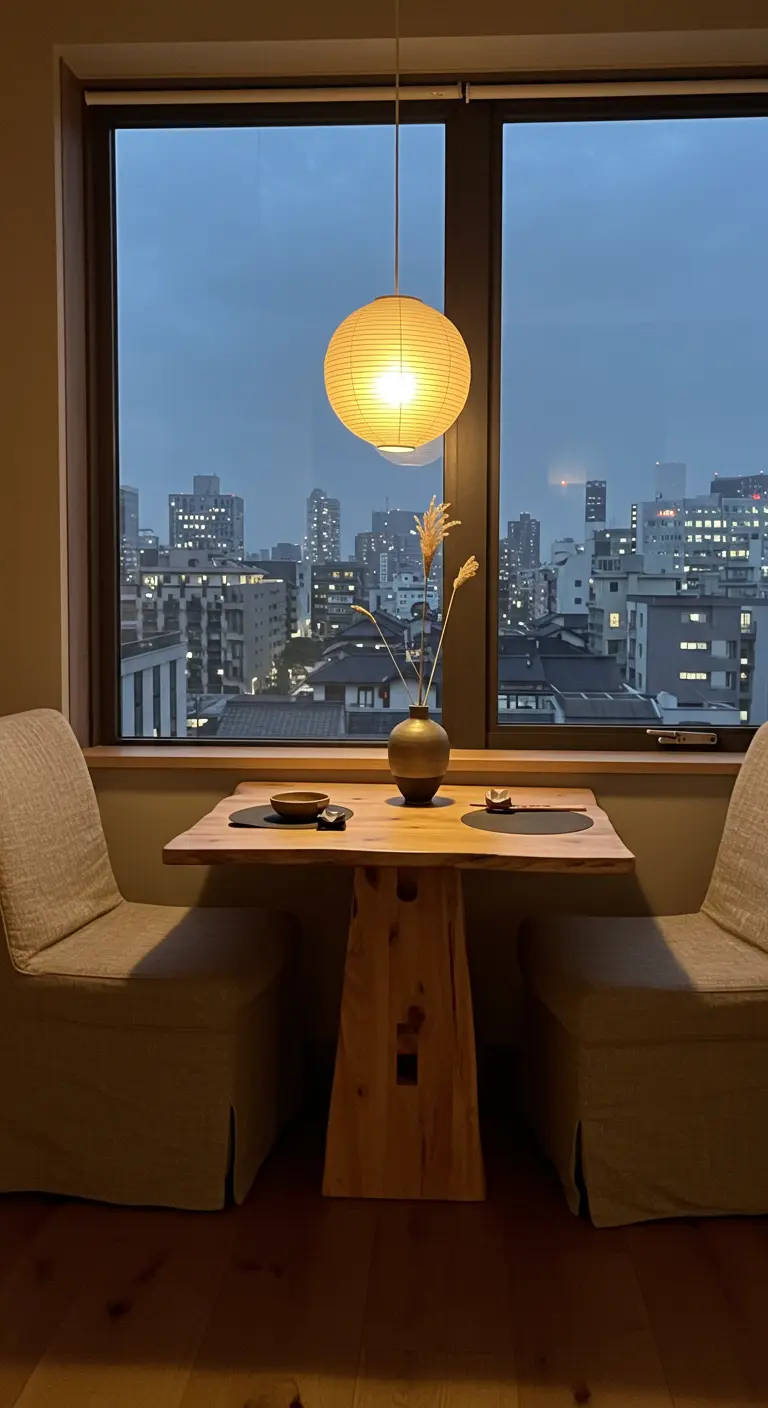
You don’t need a large room to create a dedicated dining experience.
Position a small, beautifully crafted table for two directly in front of a window to maximize the view and create a sense of occasion for everyday meals.
Hang a single paper lantern pendant low over the table; this not only provides warm, focused light but also visually anchors the space, making it feel intentional and separate.
Fully upholstered slipcover chairs add a layer of softness and comfort, inviting you to linger longer.
4. Go Moody with Dark Walls and Layered Light

Challenge the idea that Japandi must be light and airy by painting your walls and floor in a deep, enveloping charcoal or black.
The dark backdrop makes the natural texture of the oak table and the soft glow of paper lanterns stand out dramatically.
Cluster several paper lanterns of varying sizes and heights to create a sculptural cloud of light that serves as the room’s centerpiece.
This approach feels incredibly sophisticated and serene, perfect for creating moody tablescape ideas that resonate with intimacy and focus.
5. Lighten the Look with Woven Cane
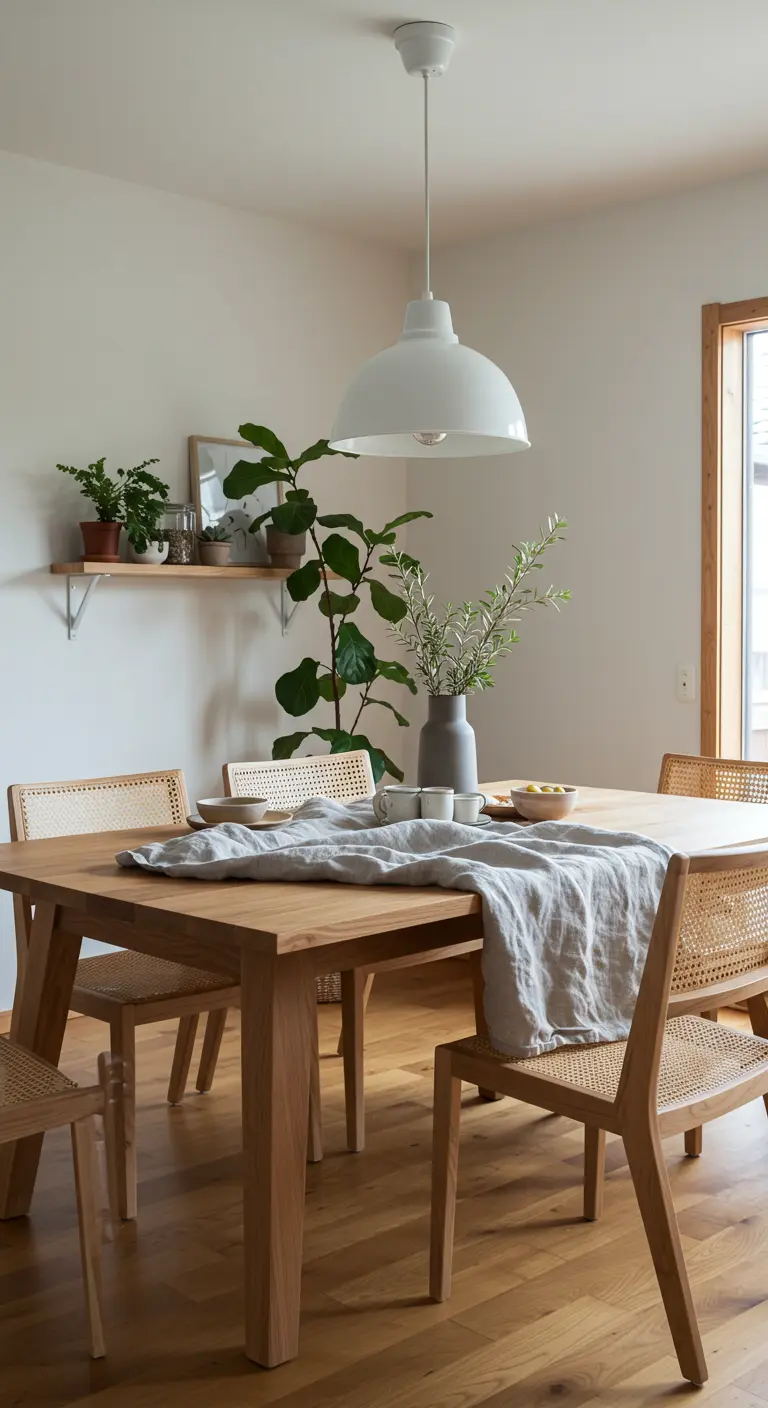
Introduce woven cane or rattan chairs to add textural interest that feels airy and light.
The delicate weave contrasts beautifully with the solid oak of the dining table, preventing the furniture set from feeling too heavy or matched.
This touch of Scandinavian-inspired craftsmanship adds a layer of warmth and detail, enhancing the overall Japandi aesthetic.
Accessorize with a casually draped linen runner and simple greenery on a high shelf to complete the fresh, natural look, similar to what you’d find in urban jungle living rooms.
6. Adopt Low-Level Living for Grounded Serenity
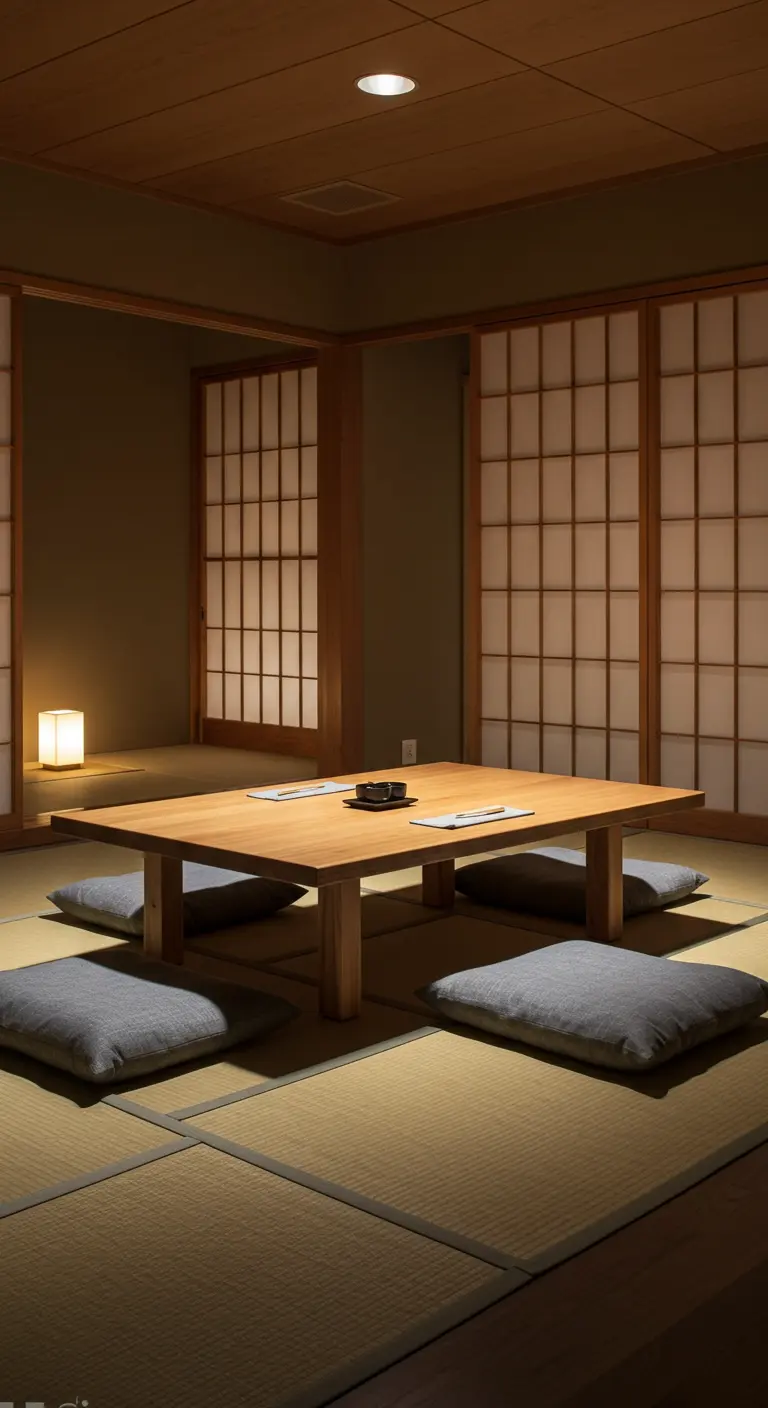
For a truly authentic Japanese dining experience, consider a low ‘chabudai’ table set on tatami mats.
This arrangement, paired with ‘zabuton’ floor cushions, physically grounds you, fostering a unique sense of calm and connection during meals.
While a full tatami room may not be practical, you can achieve a similar feel by placing a low coffee table in your living room with floor cushions for occasional, intimate dining.
The surrounding shoji screens diffuse light beautifully, a core element of these Japanese-inspired minimalist bedrooms.
7. Create Cohesion with a Matching Sideboard
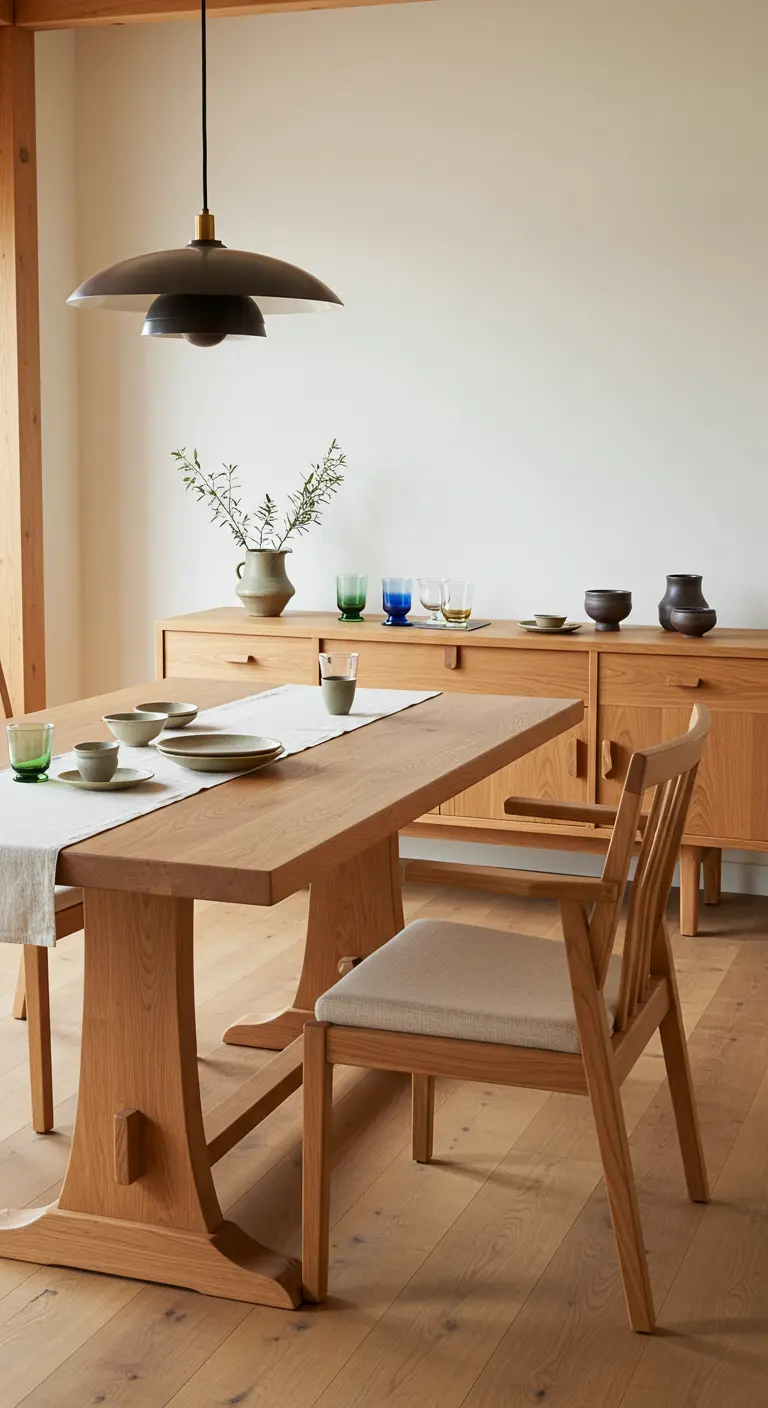
Achieve a calm, seamless look by selecting a sideboard or credenza in the same wood and style as your dining table.
This creates a powerful sense of unity and intention, making the entire space feel curated and thoughtfully designed.
The continuous wood grain draws the eye horizontally, making the room feel wider and more composed.
Use the surface to display a few carefully chosen ceramic pieces, allowing the furniture itself to be the main statement.
8. Use Nature as Your Centerpiece
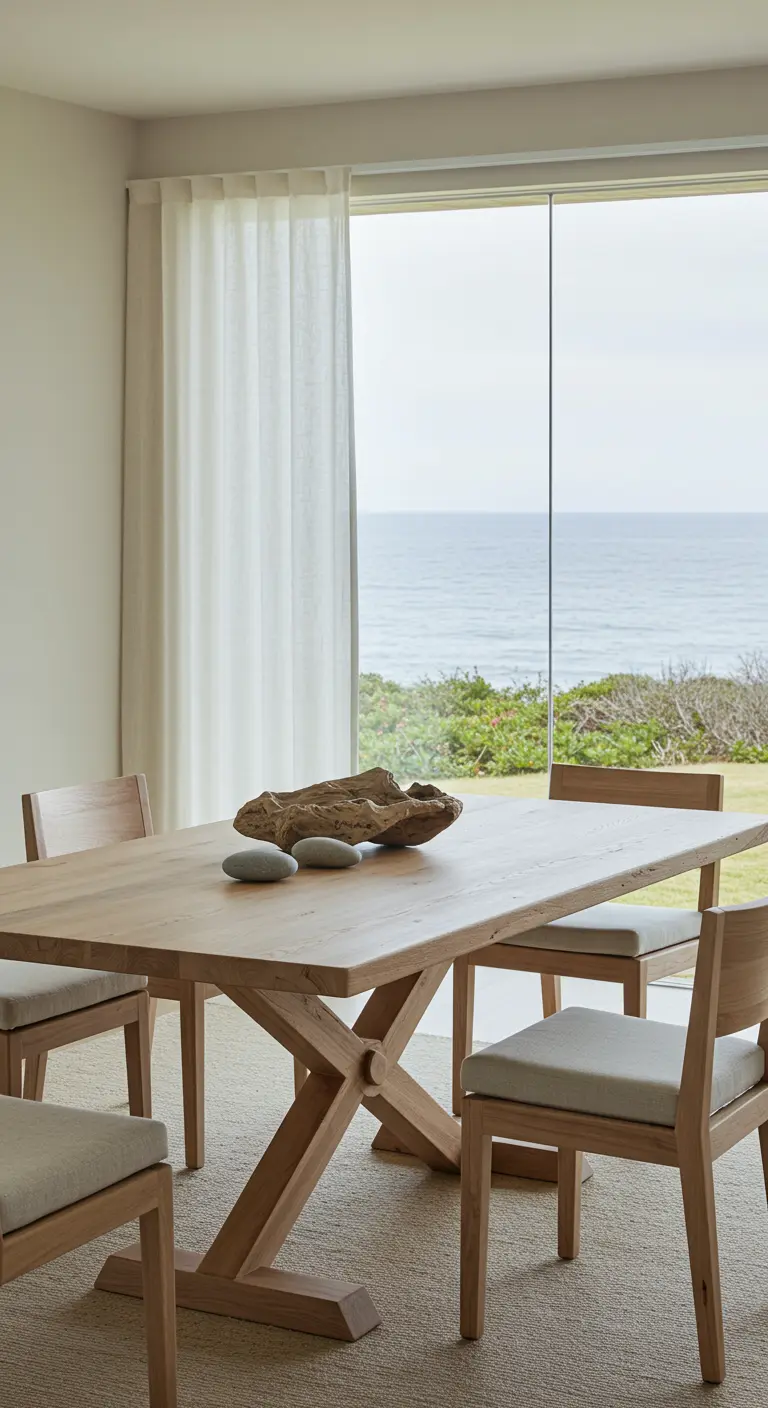
Instead of a traditional floral arrangement, choose a single, powerful natural object as your centerpiece.
A large piece of sculptural driftwood, a collection of smooth sea stones, or a moss-covered branch brings an organic, untamed element to the refined table.
This aligns with the Japanese principle of ‘wabi-sabi’—finding beauty in imperfection and nature.
It connects your indoor space to the outside world, especially effective if you have a beautiful view, and works well for coastal tablescapes.
9. Dine by the Glow of Massed Candlelight
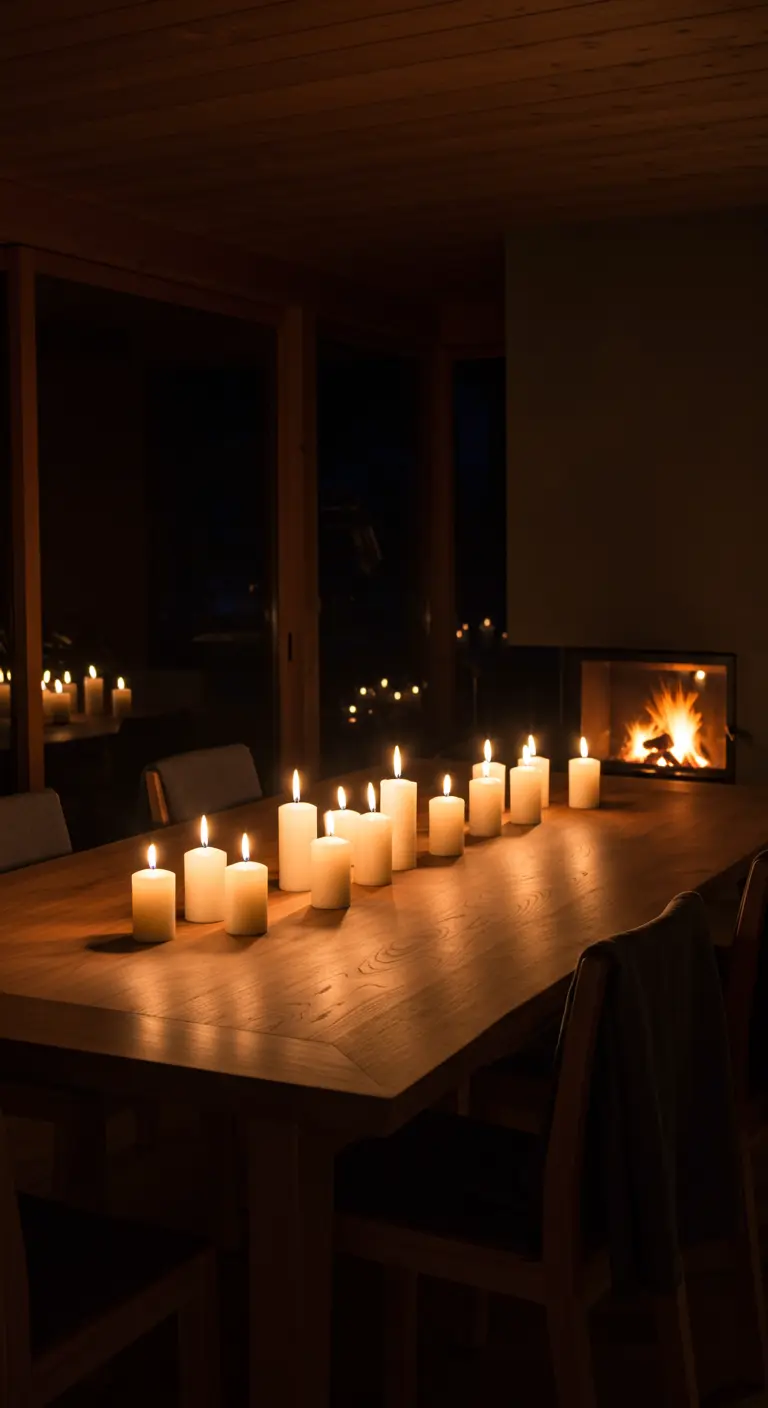
Forgo electric lights entirely for your next dinner party and rely on the elemental glow of candlelight.
Group a multitude of simple, unscented pillar and taper candles of varying heights down the center of your table.
The flickering light creates an unparalleled atmosphere of intimacy and warmth, making conversation feel more present and personal.
This technique transforms any meal into a memorable event, celebrating the simple beauty of romantic interiors.
10. Soften Industrial Edges with a Fabric Pendant
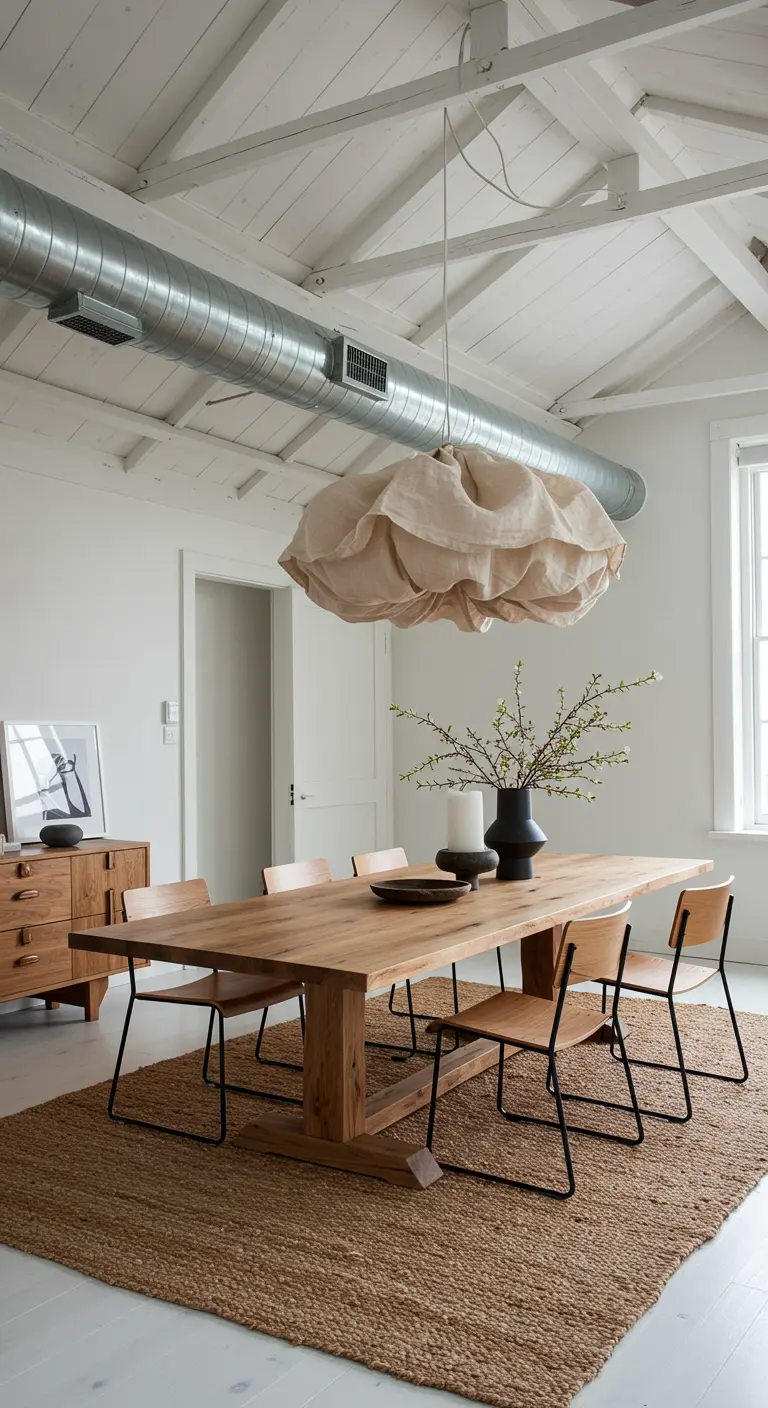
If your space has industrial features like exposed ductwork or concrete floors, counterbalance them with a soft, sculptural element.
An oversized fabric or linen pendant light acts as a cloud-like sculpture, drawing the eye and introducing a gentle, diffused light that softens the room’s hard lines.
This high-contrast pairing of industrial and soft is a hallmark of sophisticated, layered design.
A large jute rug further grounds the dining area and adds another layer of essential texture, making it one of those stylish multipurpose rooms that feels both raw and refined.
11. Build Depth with Tone-on-Tone Texture
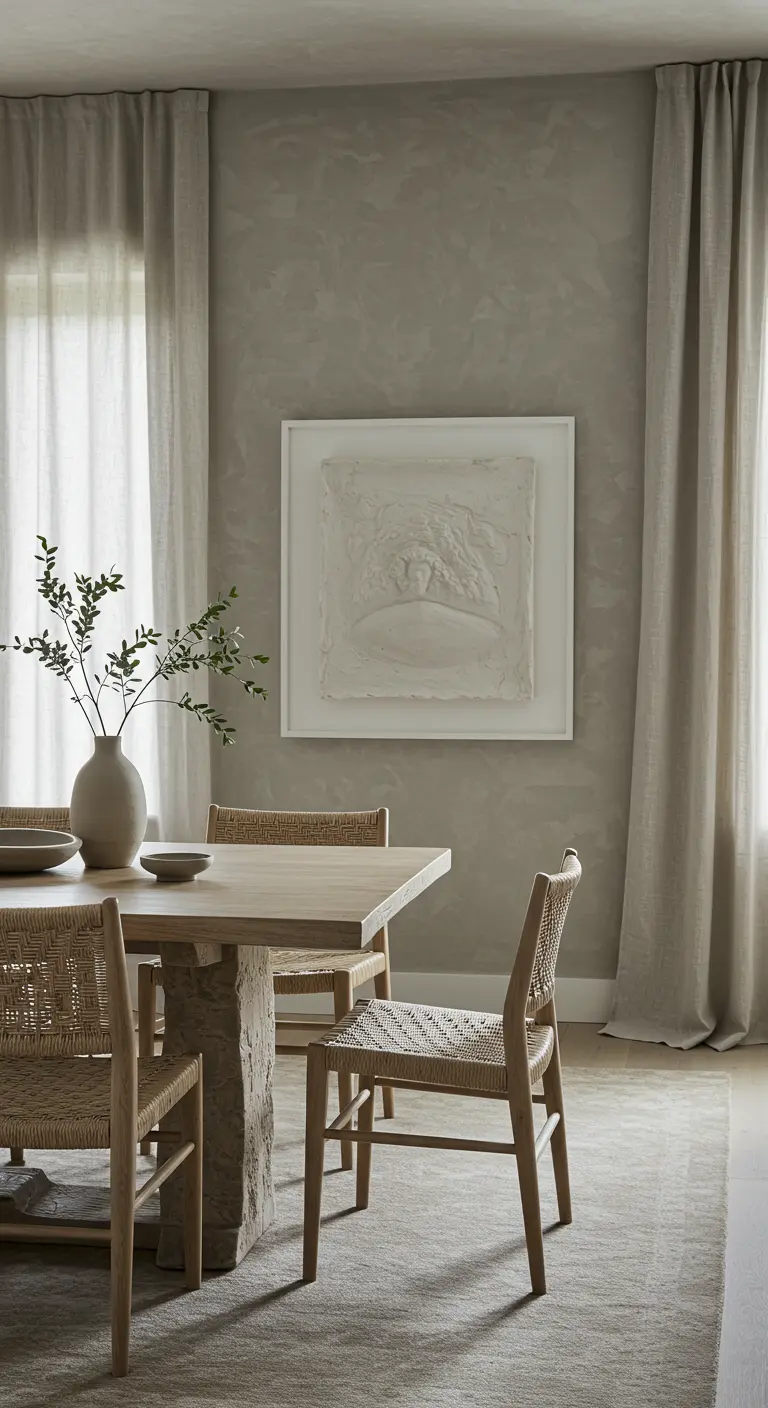
Create a rich, complex space using a strictly monochromatic palette of beige, cream, and taupe.
The key is to layer a variety of textures: the subtle pattern of the wallpaper, the rough weave of the rug, the smooth grain of the oak table, the woven rush seats, and the three-dimensional bas-relief artwork.
Each element reflects light differently, creating visual interest and a sense of quiet luxury.
This approach to serene Japandi interiors proves that a room doesn’t need bold color to have a strong personality.
12. Design a Living Centerpiece

Bring biophilic design directly to your table by creating a living runner with moss, ferns, and other low-profile plants.
Build a long, shallow wooden or metal tray to contain the arrangement, making it easy to remove for cleaning.
This biophilic element introduces a vibrant, natural texture that purifies the air and creates a unique connection to nature during meals.
It’s a stunning way to blur the lines between indoors and out, perfect for enchanting garden centerpieces that you can enjoy every day.
13. Swap Chairs for a Versatile Bench
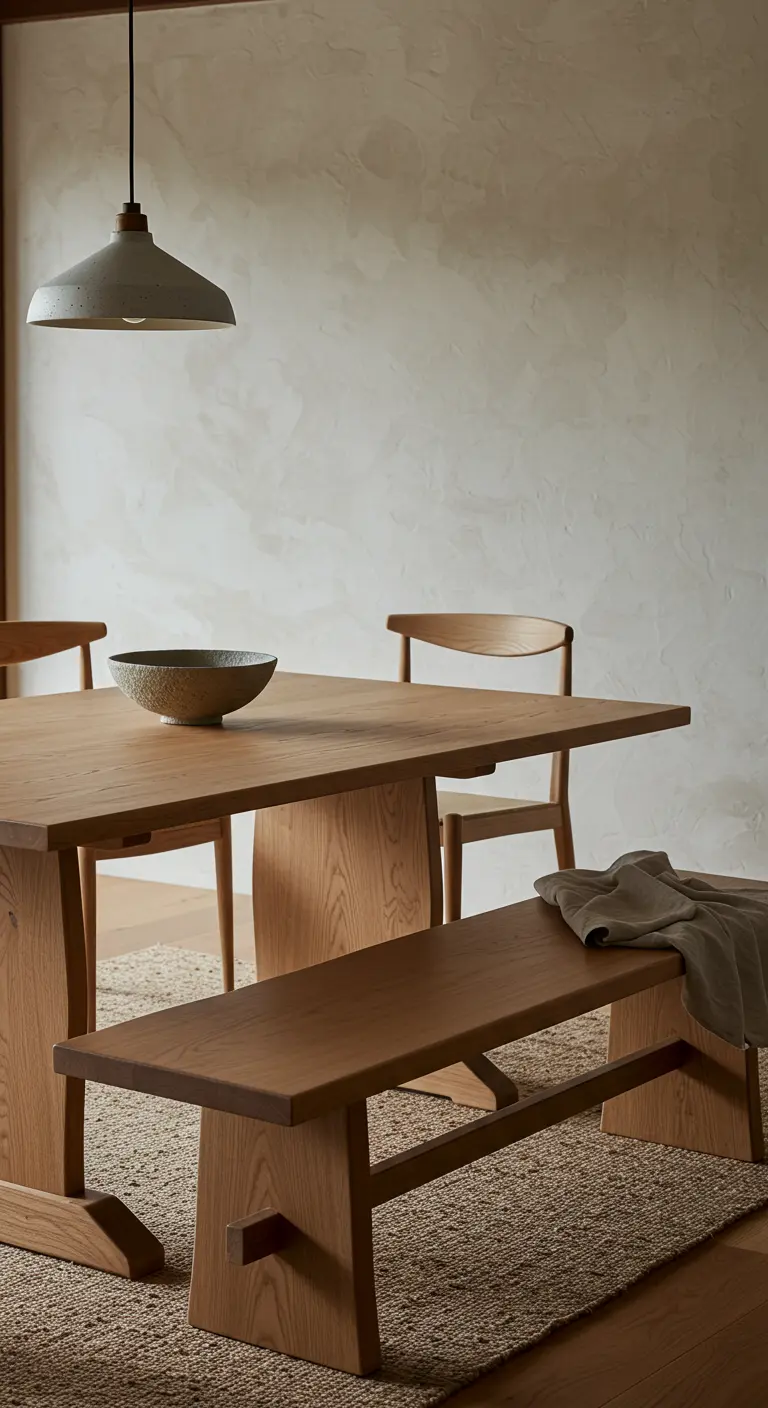
Replace chairs on one side of your dining table with a simple, backless bench.
This not only creates a more relaxed, communal feel but also offers incredible versatility—you can seat more people, and when not in use, the bench can be tucked neatly under the table to save space.
Visually, it opens up the room by reducing the number of vertical lines created by chair backs.
Choose a bench that matches the wood and style of your table for a cohesive look.
14. Update Tradition with a Modern Chandelier

If your dining room has a more formal or traditional feel with extensive wood paneling and cabinetry, a contemporary light fixture can provide a refreshing update.
Choose a linear chandelier with clean lines and simple globe bulbs, like this brass fixture.
This single change can instantly modernize the entire room, creating a beautiful tension between classic and contemporary design.
Pairing it with upholstered chairs adds softness and acoustic absorption, making the large space feel more intimate.
15. Erase the Boundary Between Inside and Out
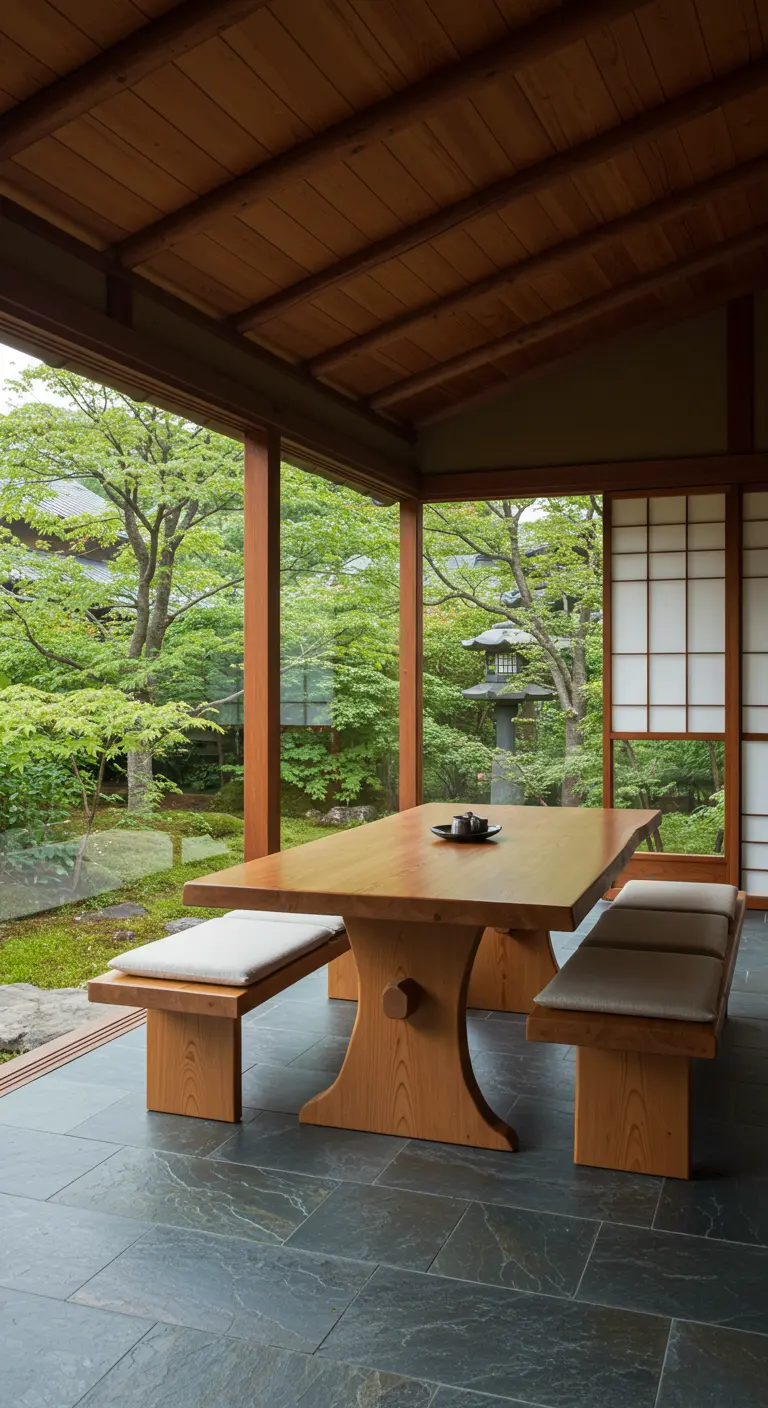
Create a seamless transition to your garden or patio by using similar materials for your indoor and outdoor flooring.
Here, the dark slate tiles extend visually into the garden, making the dining area feel like a tranquil, covered pavilion rather than a confined room.
Large sliding glass doors or windows that open completely are essential to achieving this effect.
This design fosters a deep connection with nature, turning every meal into an alfresco experience.
16. Encourage Connection with a Round Table
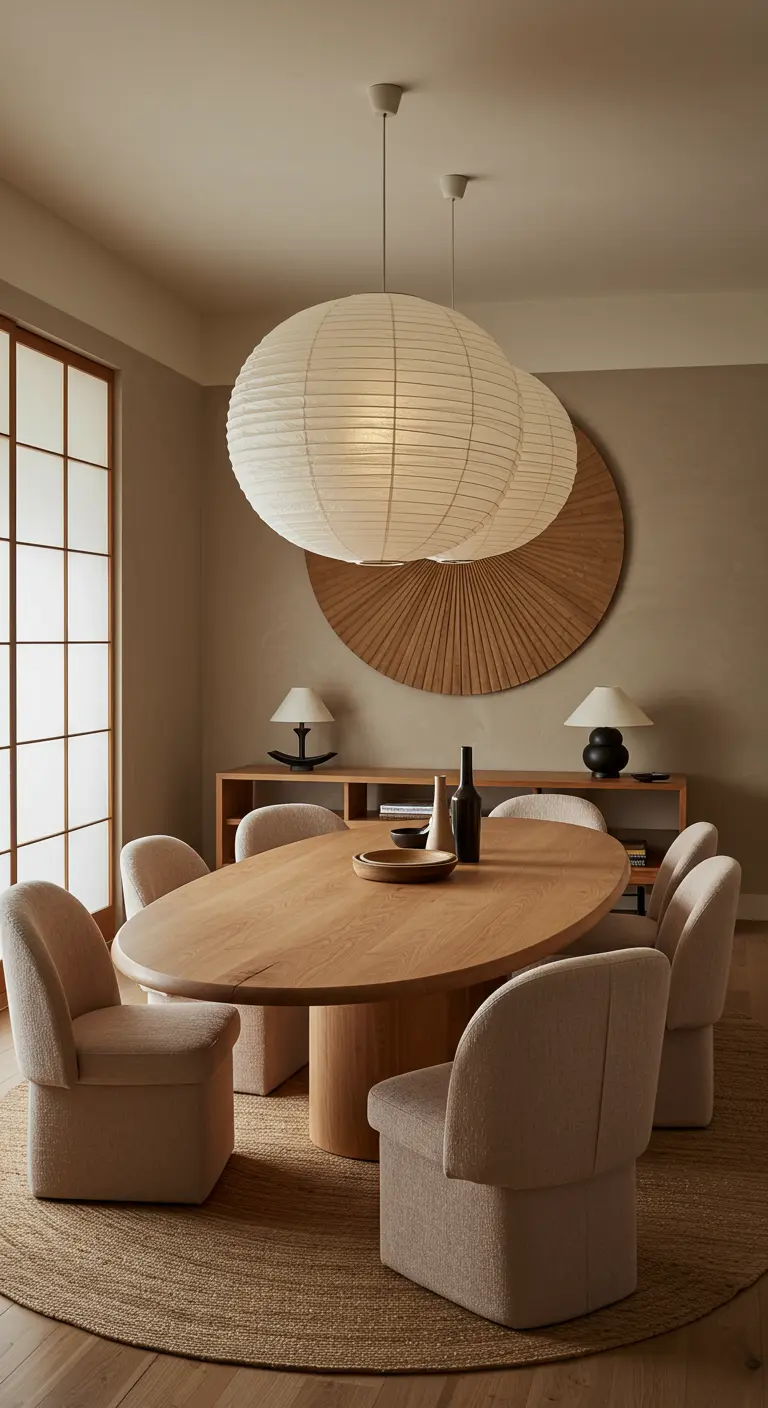
A round or oval dining table is inherently more social than a rectangular one, as it allows everyone to see and speak to each other easily.
Pair it with curved, embracing chairs in a soft texture like boucle to enhance the feeling of comfort and intimacy.
The organic shapes create a natural, gentle flow in the room, which you can emphasize with a large, round jute rug underneath.
This combination is perfect for smaller spaces or for creating a cozy dining nook within a larger room.
17. Create Drama with Architectural Branches
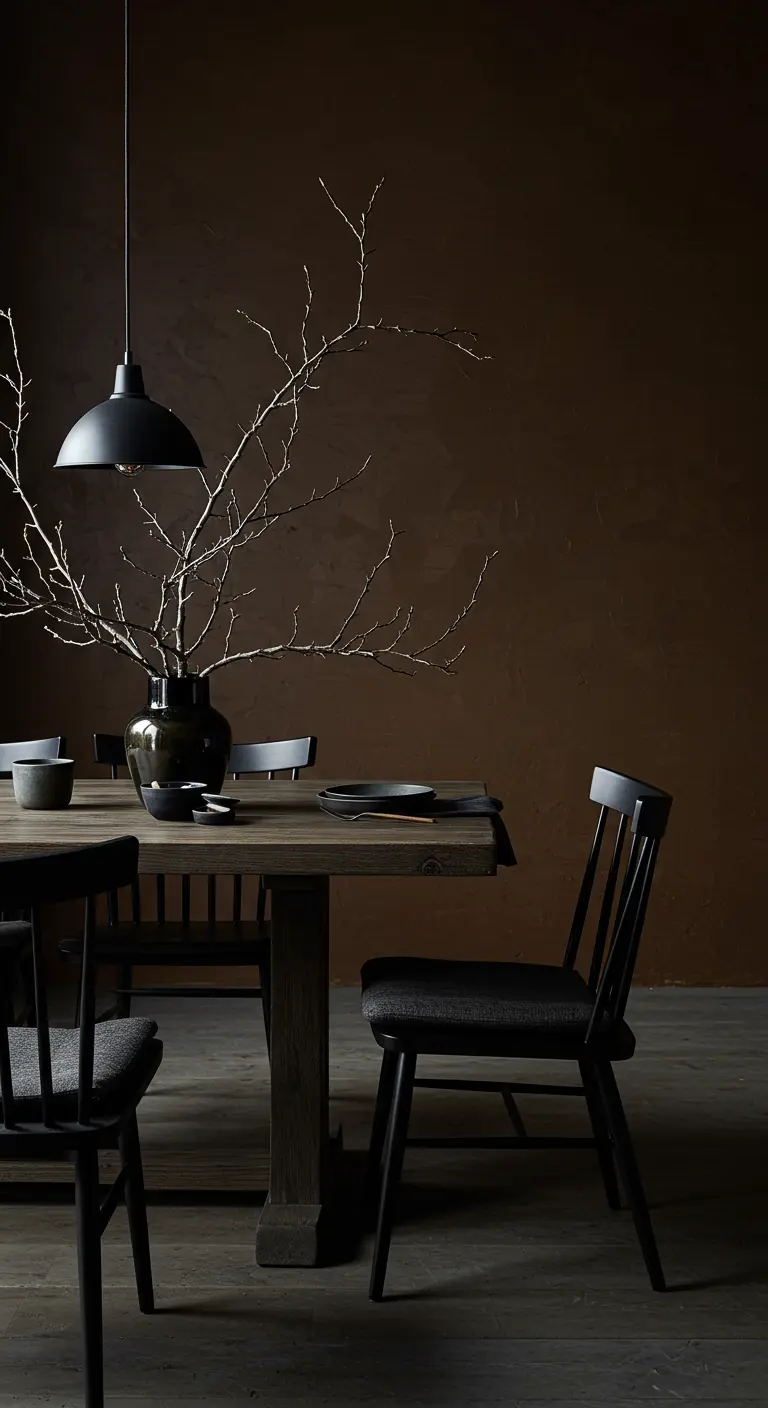
Forgo flowers and opt for a large-scale arrangement of bare, sculptural branches.
Their stark, graphic lines create a powerful focal point against a dark, moody wall, adding height and drama to the setting.
This wabi-sabi approach celebrates natural forms in their simplest state and lasts infinitely longer than fresh blooms.
Choose a vase with a dark, earthy glaze to ground the arrangement and complement the sleek matte black elements in the room.
18. Add Personality with Indigo Patterns

While Japandi often leans neutral, you can introduce pattern and color in a controlled, thoughtful way.
Use traditional Japanese-inspired indigo block-print patterns for seat cushions and throw pillows on a dining banquette.
Coordinate this with a curated collection of artisanal ceramics on open shelves, mixing patterns and solid colors.
This adds a layer of personal history and cheerfulness without overwhelming the room’s serene foundation.
19. Introduce Warmth with a Sheepskin Throw
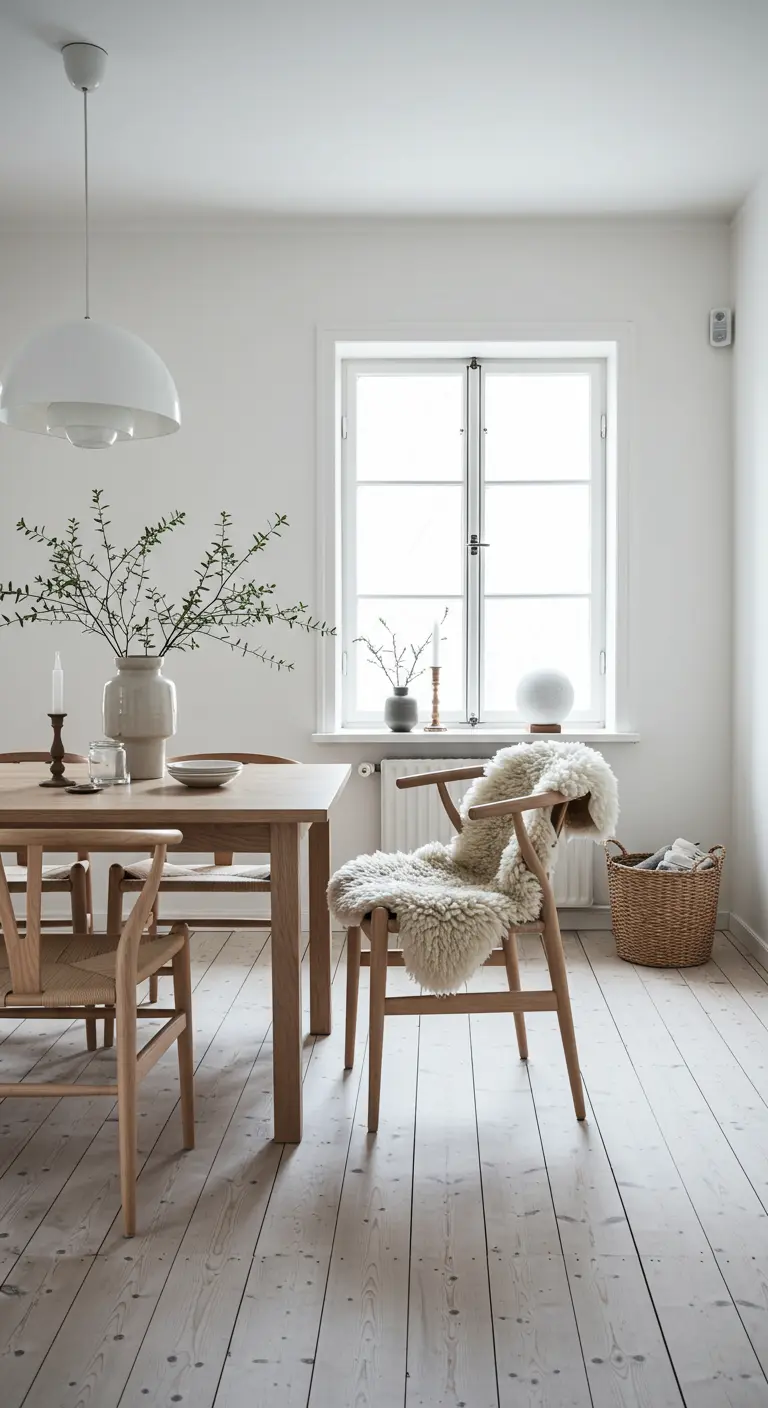
In a minimalist or all-white room, a single, high-quality texture can make all the difference.
Drape a plush sheepskin throw over one of the dining chairs, particularly a ‘captain’s chair’ at the head of the table.
It instantly adds a touch of Scandinavian ‘hygge,’ inviting touch and providing a soft contrast to the hard lines of the wooden furniture and floors.
This is one of the easiest and most effective ways to create cozy nooks and soften a space without adding clutter.
20. Elevate Your Dining Room with a Gallery Wall
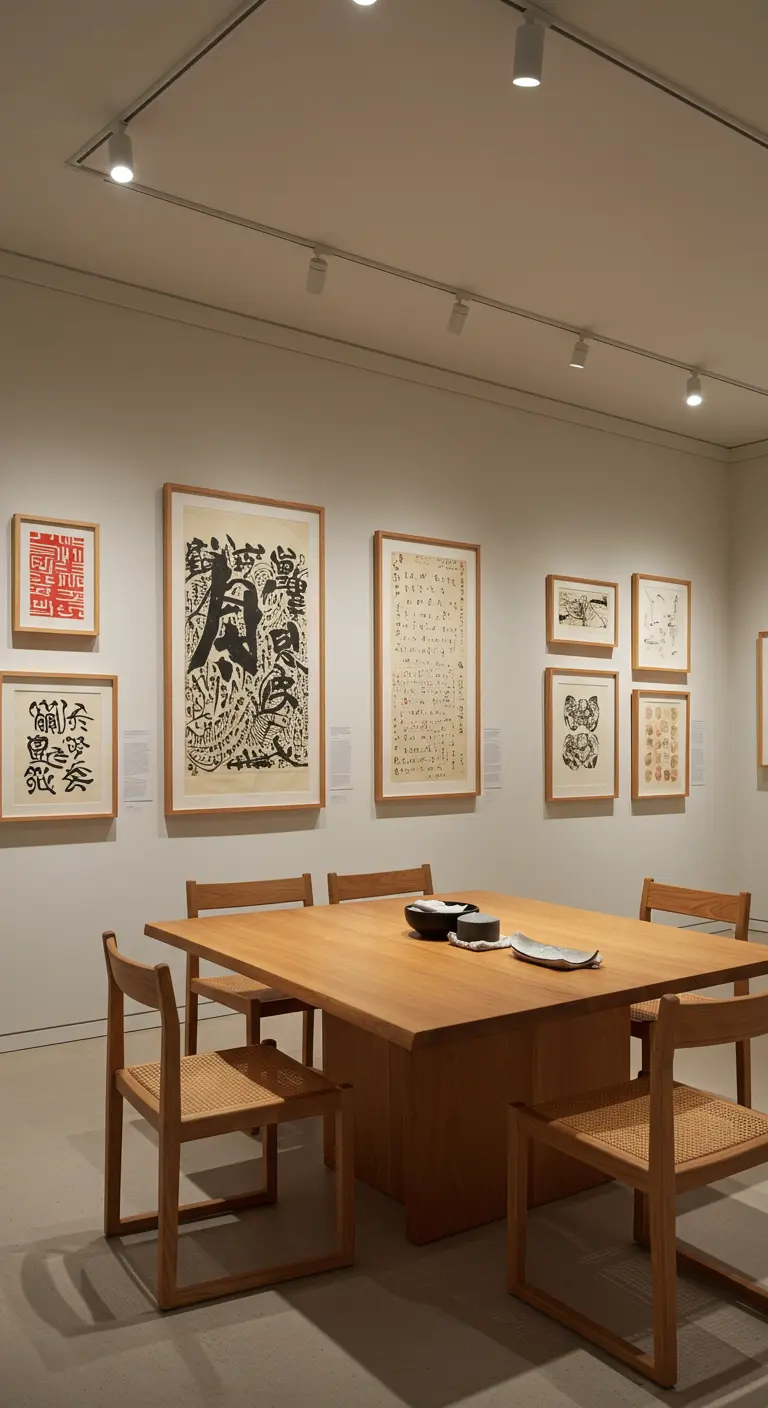
Turn a plain wall into a sophisticated focal point by creating a gallery of framed artwork.
For a Japandi feel, choose pieces with a common theme, like Japanese calligraphy or minimalist line art, and use simple, matching wood frames.
Arrange them in a loose grid to create a sense of order that still feels personal and dynamic.
Use track lighting to properly illuminate the art, which elevates the entire room from a simple eating space to a curated gallery.
21. Juxtapose Ornate Architecture with Clean Lines
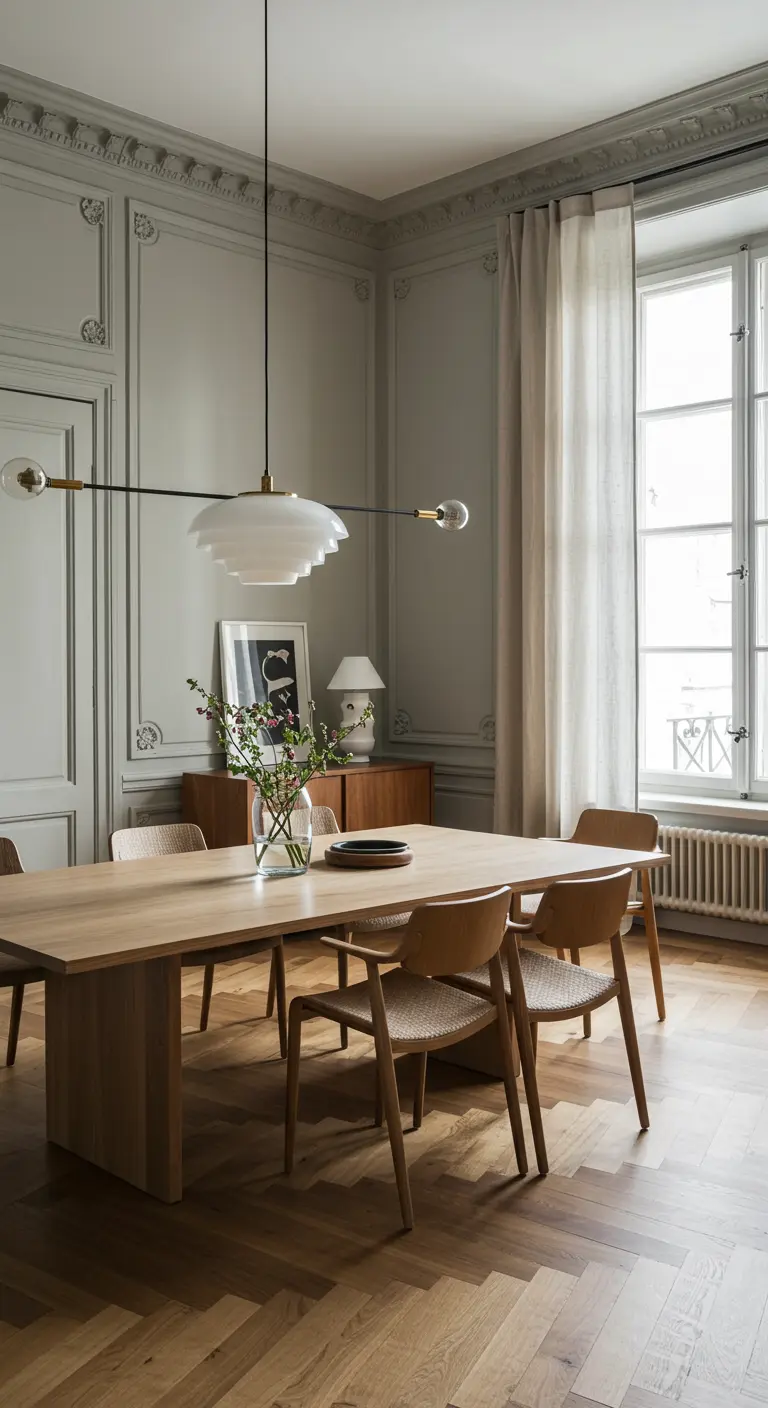
If you live in a home with historic details like ornate wall molding, don’t fight it—embrace it.
Create a stunning contrast by furnishing the room with simple, modern Japandi pieces: a raw oak table, woven chairs, and a sleek, linear light fixture.
The clean lines of the furniture will stand out beautifully against the detailed backdrop, highlighting the best of both styles.
This approach is central to creating elegant Parisian-style interiors with a contemporary twist.
22. Maximize Function with a Storage Banquette

In a smaller dining area or eat-in kitchen, a built-in banquette is a brilliant space-saving solution.
It pushes the table closer to the wall, freeing up valuable floor space, and provides comfortable, communal seating.
Incorporate deep drawers or a lift-up seat into the base of the banquette for hidden storage—perfect for stashing away table linens, seasonal decor, or serving dishes.
This clever design combines seating, storage, and style into one efficient footprint, ideal for compact urban kitchens.
23. Infuse Warmth with an Earthy Terracotta Palette
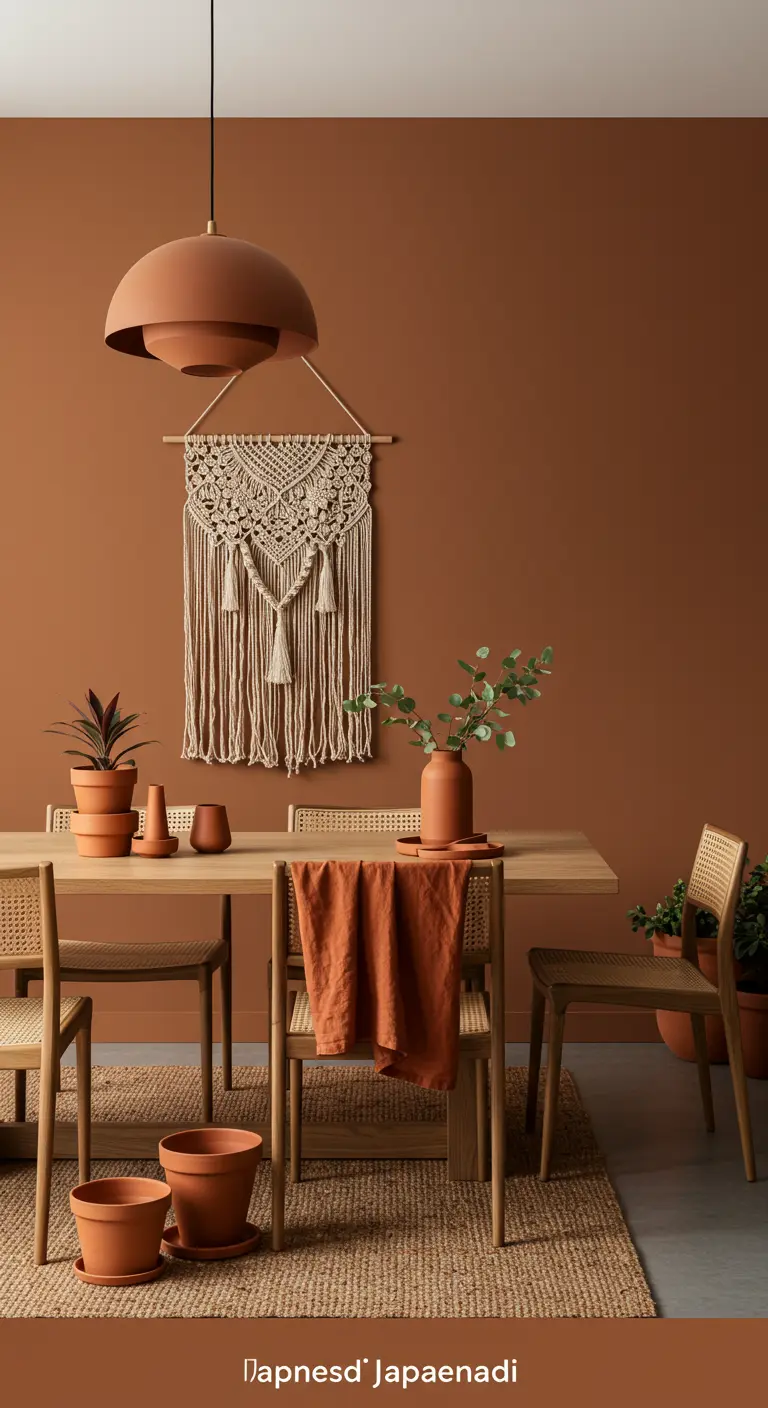
Move beyond neutral beige and embrace a warmer, earthier palette by painting your walls a rich terracotta or rust color.
This hue provides a beautiful, warm backdrop for natural oak furniture and woven textures like rattan and jute.
Add a macrame wall hanging to introduce another layer of handcrafted texture that leans into the style’s bohemian cousin.
The result is a space that feels grounded, warm, and deeply inviting, like a romantic desert oasis.
24. Let Your View Dictate the Mood
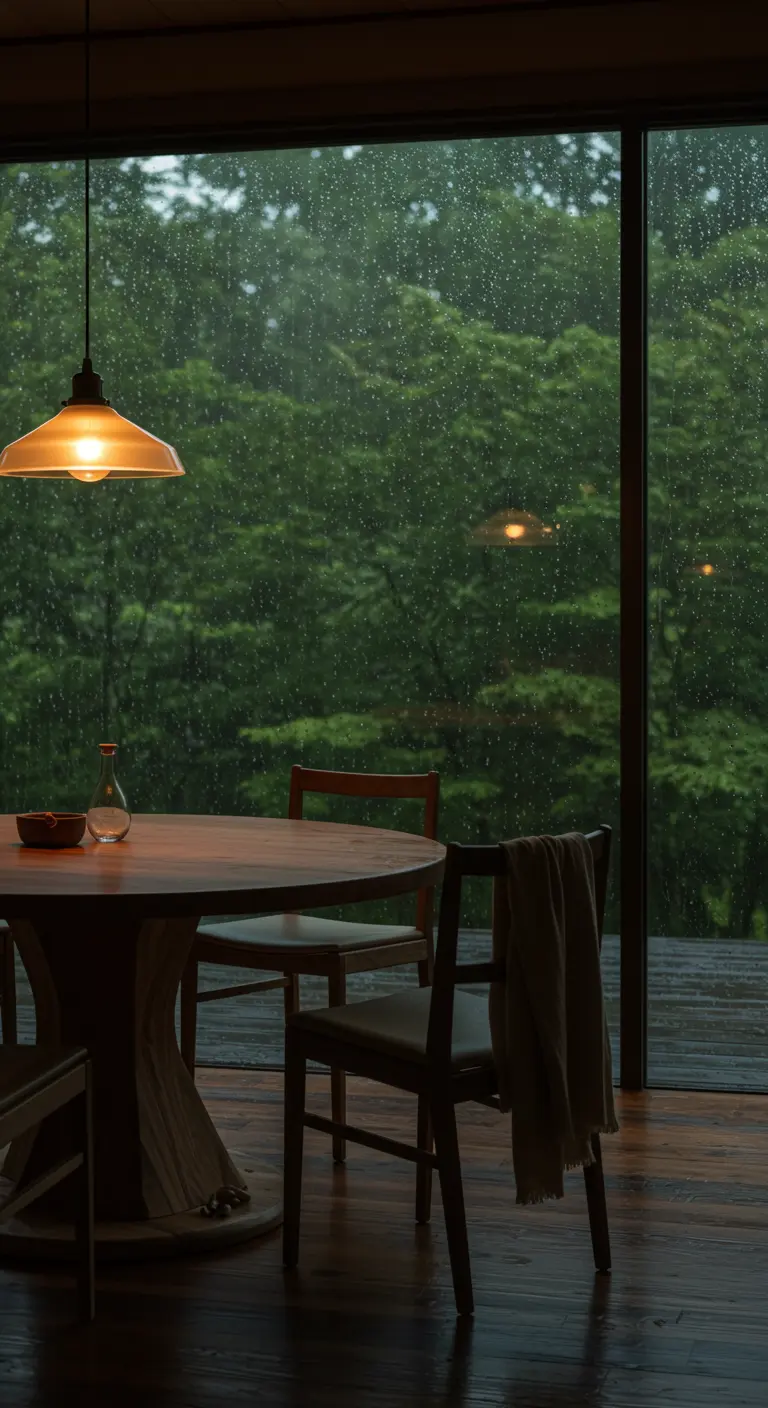
Look outside your window and let the landscape inform your interior design choices.
If you have a view of a lush, moody forest, echo that feeling inside with dark wood floors, a simple solid wood table, and warm, low-level lighting.
The goal is not to compete with the view, but to create a calm, cozy perch from which to enjoy it.
On a rainy day, the interior becomes a warm, glowing refuge that harmonizes perfectly with the scene outside.
25. Achieve Calm Through Radical Simplicity

Embrace the Japanese principle of ‘Kanso’ by decluttering your dining space down to its essential components: a table, chairs, and light.
In this room, the focus is entirely on the beautiful craftsmanship of the furniture and the soft light filtering through the shoji screen.
There is no unnecessary decoration; the beauty comes from the clean lines, the natural materials, and the feeling of open space.
This commitment to simplicity creates a profoundly peaceful environment, a core tenet of Scandinavian-Japanese fusion homes.
26. Make a Graphic Statement with Black and White
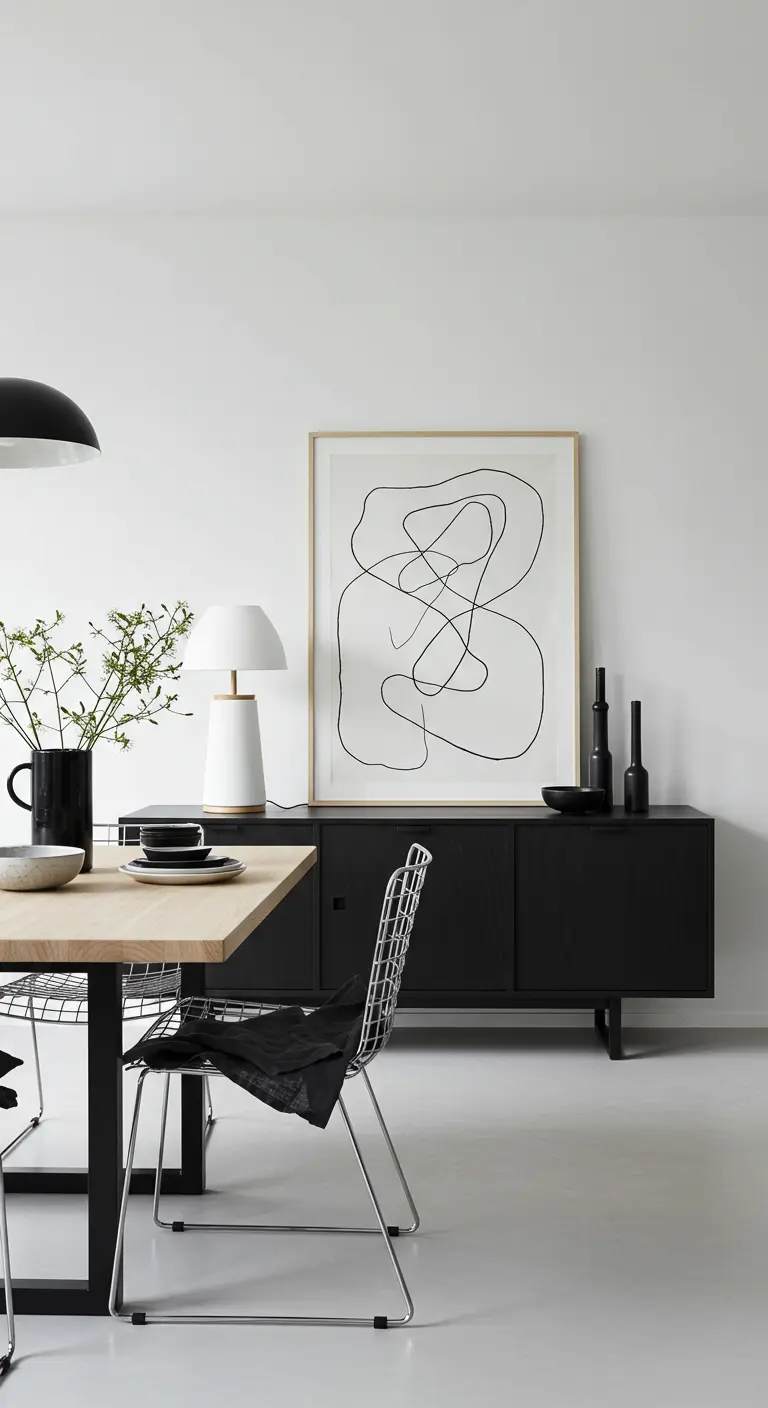
Create a bold, gallery-like dining space using a strict black and white palette.
Anchor the room with a long, low sideboard in matte black, which provides a strong horizontal line and ample storage.
Contrast this with lightweight wireframe chairs that have a graphic, see-through quality, preventing them from feeling heavy.
Complete the look by leaning a single, large-scale piece of abstract black and white art against the wall for a sophisticated, effortless feel, a key feature in black & white interiors.
27. Define the Zone with a Natural Jute Rug
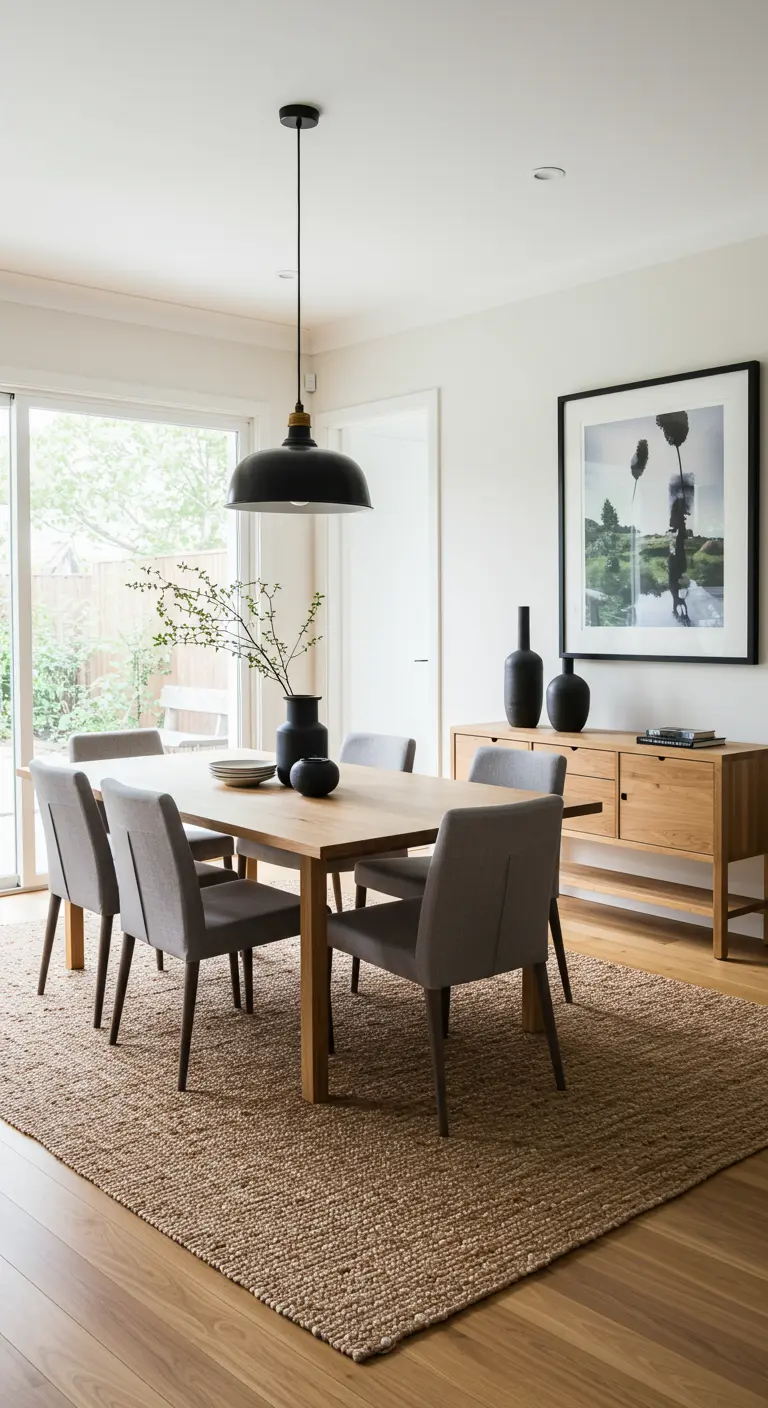
In an open-plan living or dining area, a large rug is the most effective way to define the dining zone.
Choose a durable, natural fiber rug like jute or sisal that is large enough for all chair legs to remain on it, even when pulled out.
The natural texture adds warmth and a relaxed feel that complements the raw oak furniture perfectly.
It visually anchors the table and chairs, creating a cohesive and intentional ‘room within a room’.
28. Blend Japandi Simplicity with Rustic Warmth

The clean lines and natural materials of Japandi design can beautifully complement a more rustic, lodge-style architecture.
Choose a dining table and chairs with simple, strong silhouettes made from solid, reclaimed-style wood that echoes the ceiling beams and mantel.
Avoid ornate details. Instead, let the natural beauty of the wood and the texture of the stone fireplace be the focus.
This creates a space that feels both grand and grounded, merging the best of modern rustic spaces with Japanese minimalism.
29. Create an Ethereal Look with ‘Ghost’ Chairs
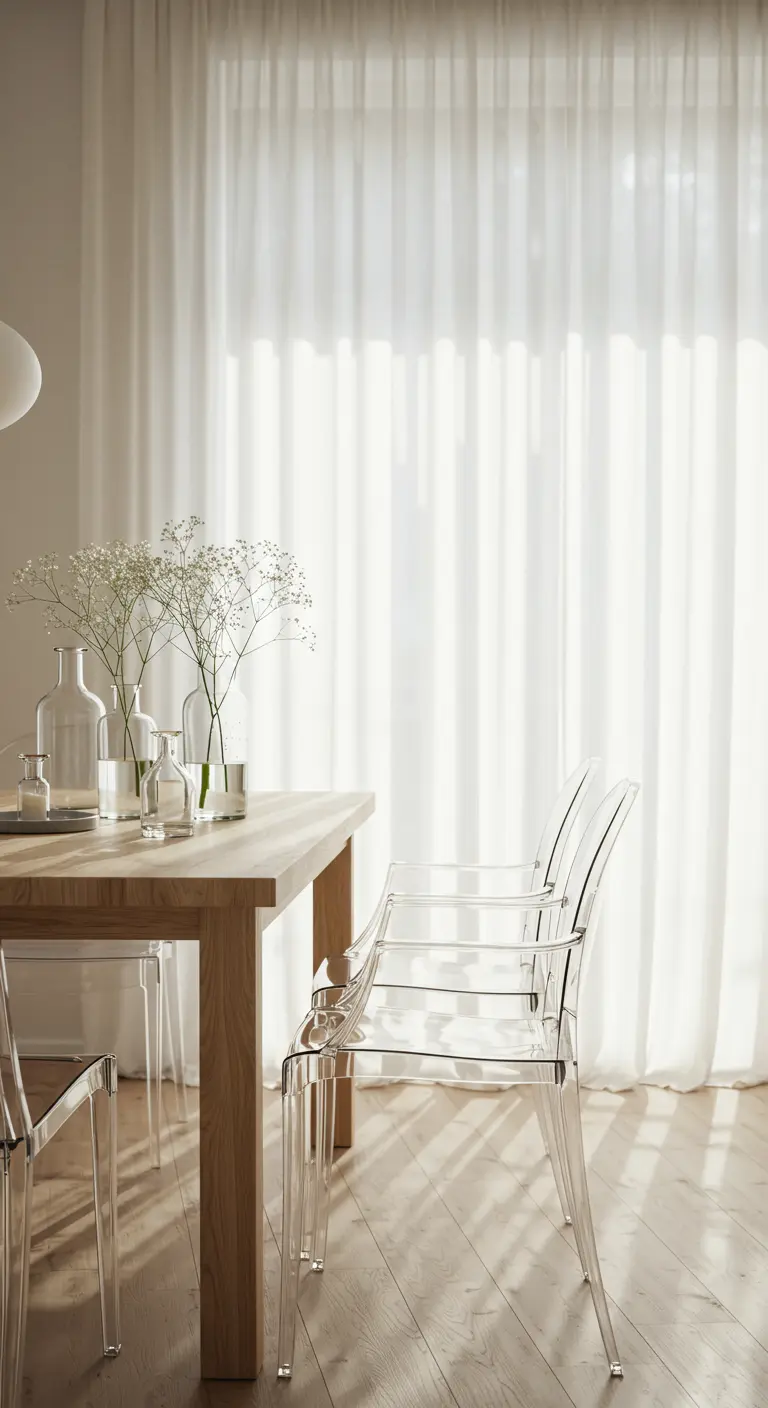
In a smaller dining room or one where you want to maximize the feeling of light and airiness, consider transparent acrylic chairs.
These ‘ghost’ chairs have almost no visual weight, allowing light to pass through them and keeping sightlines completely open.
They provide functional seating without cluttering the space, making the room feel larger and more open.
Paired with a simple wood table and diaphanous white curtains, the effect is wonderfully light and ethereal, a signature of white-on-white interiors.
30. Unify a Multi-Functional Library & Dining Space

When your dining table must also serve as a desk, create a cohesive look by integrating it with your storage.
Custom, floor-to-ceiling shelving in the same oak as the table and chair creates a unified, library-like feel.
The grid of the shelves provides visual structure, while the shared material makes the table feel like a deliberate part of the overall design, not an afterthought.
This is a sophisticated way to handle inspiring ways to combine workspaces and living areas gracefully.
31. Create Ambiance with an Illuminated Indoor Tree
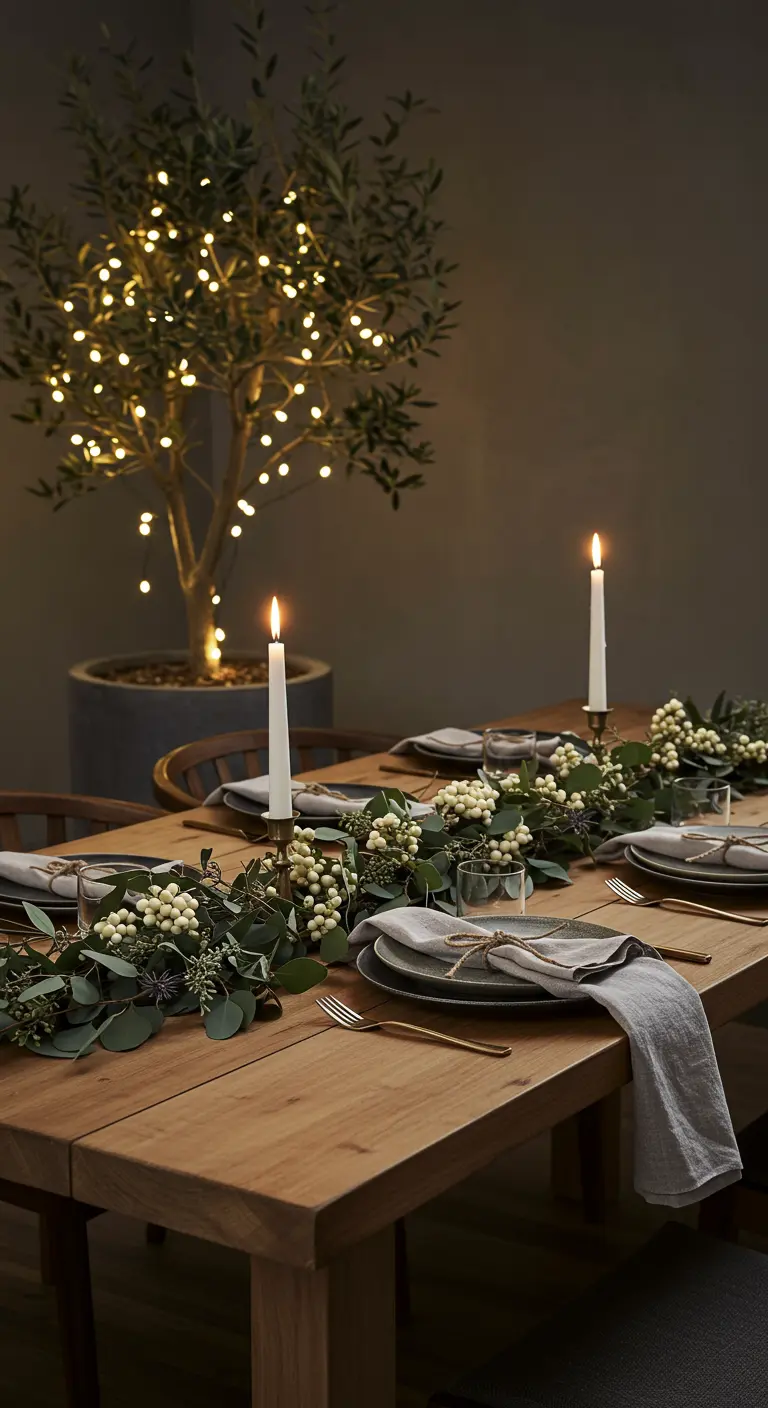
Bring a touch of enchantment to your dining room by placing a large potted tree, like an olive or ficus, in a corner.
Weave warm-white fairy lights delicately through its branches to create a magical, secondary light source.
This living element adds height, organic shape, and a gentle, sparkling glow that feels festive yet elegant enough for year-round enjoyment.
It’s a beautiful alternative to a standard floor lamp and a key element in crafting romantic, candlelit tablescape ideas.


